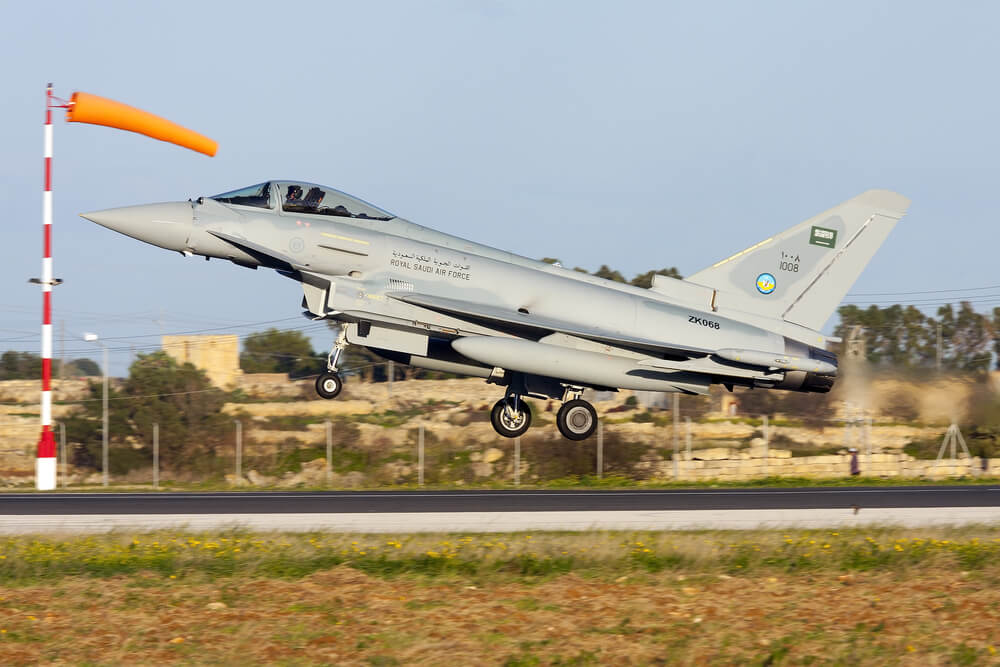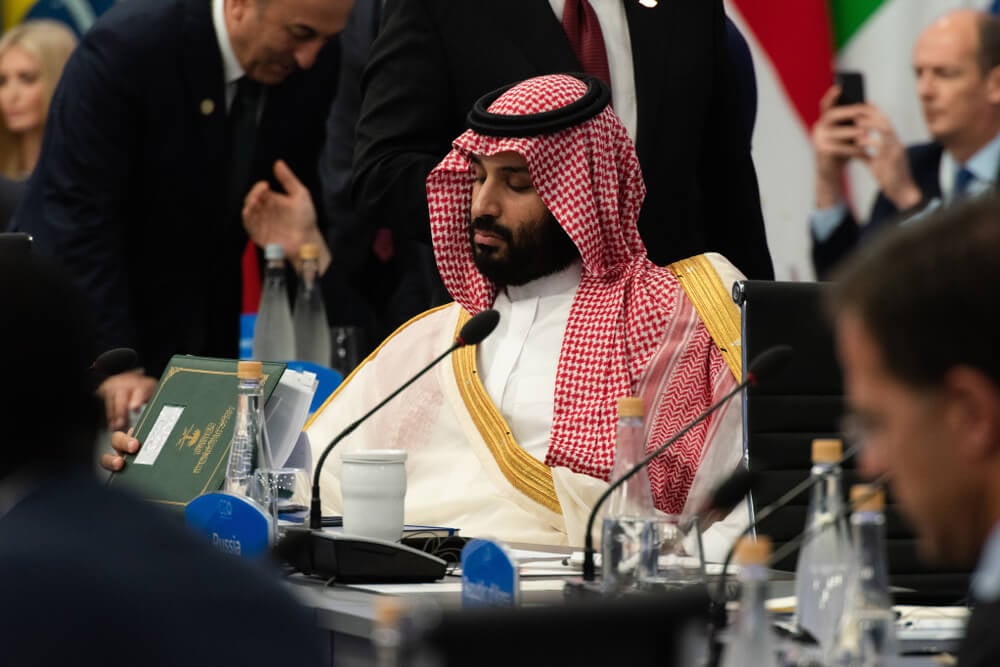Yesterday's signing at the White House between President Donald J. Trump and Crown Prince Mohammad bin Salman formalises the “U.S.–Saudi Strategic Defence and Security Cooperation Treaty,” a comprehensive framework that redefines the depth and direction of the bilateral relationship.
With this treaty, Saudi Arabia has also been formally designated a U.S. Major Non-NATO Ally (MNNA).
This second designation carries enormous strategic weight. It places the Kingdom in a category reserved only for Washington’s closest security partners and opens the way for the accelerated transfer of high-end military technologies, advanced systems, and sensitive research cooperation that would otherwise take years to authorise.
Within this context, the initiation of the F-35A acquisition track emerges as the pivotal decision.
It is the step that determines the architecture into which all other systems agreed today must fit.
It marks the moment an Arab state enters the 5th-generation domain, and from this point onwards, the military balance of the Middle East will evolve around that fact.
The scale and the consequences of what was agreed today will gradually reshape the strategic landscape of the region for years to come.
Israel’s anxiety is not emotional
The intense Israeli reaction this past week underscores how consequential this shift truly is.
The Israeli Prime Minister made a direct and forceful attempt to prevent or condition the transfer.
He reached into the highest ranks of the Trump administration, mobilised long-standing political allies, and exerted pressure through congressional channels.
The objective was simple: no F-35A for Saudi Arabia without overt Saudi recognition of Israel. President Trump refused.
That refusal, given the political weight behind the Israeli effort, is significant in its own right.
Israel’s anxiety is not emotional; it is grounded in a detailed assessment prepared by its own military intelligence.
That assessment identifies Saudi Arabia as the only regional state with both the scale and the institutional capacity to build an air-dominance structure that could, over time, challenge Israel’s long-held superiority.
The combination of the F-35A track, the expected F-15EX expansion, advanced missile-defence layers, classified ISR platforms, large MQ-9B fleets, and a maturing C6ISR grid alters the underlying calculus of regional airpower.
This is not rhetoric. It is the cold, technical reading from within the Israeli national defence system.
Washington will not permit an environment in which two American-equipped 5th-generation forces could ever confront one another militarily
And there is another dimension that emerged today. By enabling both Saudi Arabia and Israel to operate the F-35A, the United States has locked the strategic relationship between both countries into a new configuration.
Washington will not permit an environment in which two American-equipped 5th-generation forces could ever confront one another militarily.
The technological and strategic risks are far too great. The result is that the F-35A becomes not only a platform for capabilities but also a structural stabiliser between America’s two central regional partners.
This single fact will influence alliance behaviour, war planning, and the conduct of regional strategy for decades.
F-35 anchors the emerging Saudi national defence grid
The operational value of the F-35A lies not simply in stealth or sensor-fusion but in the way it anchors the emerging Saudi national defence grid.
On the Block 4 path, the aircraft becomes the central processing node through which every major sensor and shooter in the Kingdom’s architecture will ultimately flow: Patriot PAC-3/MSE, THAAD, MQ-9B, naval sensors, the Kingdom’s AWACS fleet and the next generation of airborne early-warning and battle-management aircraft, national radar networks, cyber systems, and the classified high-altitude and airborne ISR assets included in today’s agreements.
These ISR systems close long-established intelligence gaps and extend Saudi strategic warning time in ways that simply did not exist in the past.
AWACS and advanced AEW platforms complete the air picture, sustaining the wide-area management layer essential for a modern Air & Space, Air Defence, and Strategic Missile Forces.
Parallel to this sits the F-15EX track and, alongside it, the existing F-15SA and Typhoon Eurofighter.
Saudi Arabia already operates the largest F-15 force outside the United States and the largest Typhoon fleet outside the three core European consortium states.
 The Eurofighter Typhoon remains a critical 4.5-generation pillar in the order of battle,
The Eurofighter Typhoon remains a critical 4.5-generation pillar in the order of battle,
The Eurofighter Typhoon remains a critical 4.5-generation pillar in the order of battle, providing high-end air defence and multirole capacity that dovetails with the heavier F-15EX and the 5th-generation F-35A.
With new-generation AESA radar, digital EW systems, extended range, increased payload, and compatibility with long-range and hypersonic weapons, the EX will carry the heavy strike burden, while the Typhoon reinforces the air-defence and multirole envelope, and the F-35A defines air dominance and battle management.
Together, these three platforms form a complementary structure built around mass, range, survivability, and information superiority.
Given its size, geography, and responsibilities, Saudi Arabia must move towards a fleet of approximately 500 advanced combat airframes drawn from 4.5-generation and 5th-generation platforms (for an expanded Air Force capacity of at least 1,500 aeroplanes).
This is not aspirational; it is the minimum scale required for sustained deterrence and credible interdiction across multiple theatres.
The backbone of the Kingdom’s future defensive and offensive posture
The Kingdom already commands the most powerful Arab air force and the largest concentration of 4.5-generation aircraft in the Middle East. Today’s agreements bring that force closer to the necessary depth and endurance.
On the ground, the acquisition of about 300 additional M1A2 Abrams tanks—equipped with next-generation armour and battle-management systems—brings the Royal Saudi Land Forces to roughly 1000 Abrams in total.
For a country of Saudi Arabia’s terrain and strategic exposure, this is the minimum scale needed to maintain decisive ground capabilities.
These systems, together, form the backbone of the Kingdom’s future defensive and offensive posture
The MQ-9B SeaGuardian/Reaper fleet establishes a continuous 24/7 ISR umbrella, feeding real-time information directly into the F-35A/F-15EX-F15SA-Typhoon operating picture.
This is the persistent reconnaissance layer that modern airpower requires.
Patriot PAC-3/MSE modernisation, expanded THAAD batteries, upgraded AWACS and AEW command platforms, radar reinforcement, secure communications, and the long-term training pipeline complete the structure and bring coherence to the national C6ISR grid.
These systems, together, form the backbone of the Kingdom’s future defensive and offensive posture.
Software sovereignty
No element of this architecture reaches its full potential without addressing software sovereignty.
The Mission Data Files (MDFs) of the F-35A—and the advanced EW libraries of the F-15EX—are the true operational brain of the system.
They decide what the aircraft sees, how it interprets its environment, and the logic by which it engages.
This is the most restricted domain of American export policy. Full independence is not something Washington grants.
But Saudi Arabia must have structured access through joint reprogramming labs, shared workflows, and active participation in defining the threat libraries that matter for the Kingdom’s environment.
The United States will not transfer full source code, but the Israeli example demonstrates what negotiated access corridors can look like when Washington is willing to authorise them
Source-code governance forms the second critical pillar. The United States will not transfer full source code, but the Israeli example demonstrates what negotiated access corridors can look like when Washington is willing to authorise them.
Israel secured the right to integrate national weapons, adjust certain mission layers, and align avionics with its doctrine.
This issue became even more pointed after the Israeli strike on Qatar. In that operation, the Israeli Air Force employed an upgraded F-15I fitted with an indigenously integrated air-launched ballistic missile (ALB).
From international airspace above the Red Sea, the aircraft released the missile, pushed it briefly into a suborbital trajectory, and brought it back at extreme velocity onto its target—without entering Saudi airspace.
The feasibility of that strike rested entirely on Israeli access to a degree of source-code integration authority, limited but sufficient to alter mission systems, integrate national technologies, and craft a flight profile tailored to Israeli planning.
For Saudi Arabia, securing equivalent structured pathways is essential. The Kingdom must be able to integrate national weapons, expand sensors, evolve datalinks, update avionics, and adjust mission layers on its own timetable.
Without these corridors, the long-term strategic value of these platforms would be curtailed. With them, Saudi Arabia secures true operational sovereignty and the capability to evolve its force to meet future demands.
The central stabilising power of the Middle East
Today’s agreements create the military foundation that allows Saudi Arabia to step fully into its natural strategic role: the central stabilising power of the Middle East.
 The agreements create the military foundation that allows Saudi Arabia to step fully into its natural strategic role: the central stabilising power of the Middle East - Crown Prince Mohammed bin Salman
The agreements create the military foundation that allows Saudi Arabia to step fully into its natural strategic role: the central stabilising power of the Middle East - Crown Prince Mohammed bin Salman
This is the position from which the United States—and the broader international community—can depend on Saudi leadership to deliver the only two outcomes capable of producing a durable peace in the region: the establishment of a Palestinian state and the eventual recognition of Israel within a framework that introduces Israel to the wider Arab and Muslim worlds.
No other state possesses the legitimacy, the reach, or the institutional depth to deliver both.
This understanding is no longer limited to defence planners; it is now openly recognised at the highest level of the U.S. government.
During an interview yesterday on Fox News, U.S. Treasury Secretary Scott Bessent stated plainly: “Saudi Arabia is now the premier military partner for the United States in the Middle East — the country Washington depends on to keep stability in the region. With these new capabilities, that role only grows.”
This acknowledgement reflects a broader shift in American thinking about regional stability and the Kingdom’s central role in shaping it.
The consequences of these accords will shape the military, political, and diplomatic landscape of the Middle East for decades ahead.
Dr Nawaf Obaid is a Senior Research Fellow at the Department of War Studies, King’s College London.